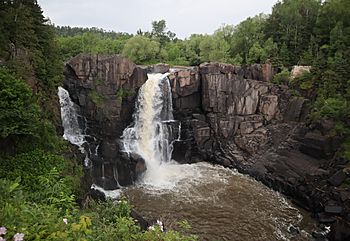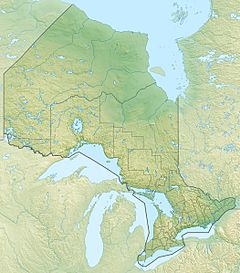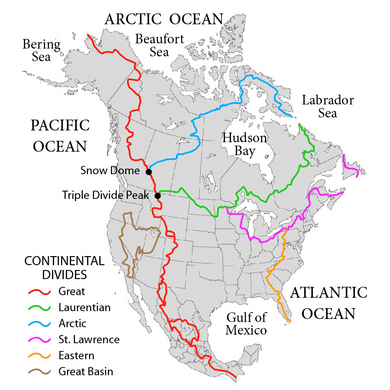Pigeon River (Minnesota–Ontario) facts for kids
Quick facts for kids Pigeon River |
|
|---|---|

The Pigeon River High Falls
|
|
|
Mouth of the Pigeon River
|
|
| Native name | Rivière aux Tourtres |
| Country | Canada and United States |
| Region | Minnesota and Ontario |
| County | Cook |
| Physical characteristics | |
| Main source | South Fowl Lake 614 feet (187 m) 48°02′23″N 89°59′47″W / 48.0396086°N 89.9964786°W |
| River mouth | Pigeon Point, Lake Superior 47°59′57″N 89°34′10″W / 47.9991667°N 89.5694444°W |
| Length | 31.2 miles (50.2 km) |
The Pigeon River is a special river that helps form the border between two countries: Canada and the United States. It flows between the state of Minnesota and the province of Ontario, just west of Lake Superior. Long ago, before cars and trains, this river was super important for travel and trading animal furs. People used canoes to move goods and explore the land.
Contents
About the River's Journey
The Pigeon River flows east from a wild area called the Boundary Waters Canoe Area Wilderness. It travels for about 31 miles (50 kilometers) before emptying into Lake Superior. The Pigeon is one of the bigger rivers that flows into Lake Superior from its North Shore.
Where the River Starts
The Pigeon River begins in a series of lakes along the border between the U.S. and Canada. The highest and furthest west of these is Mountain Lake. One of the Pigeon's smaller rivers, the Arrow River in Ontario, starts in South Lake.
South Lake is very close to North Lake, which is part of a different river system called the Rainy River. A narrow strip of land separates these lakes. This land is part of the Laurentian Divide, a natural ridge that separates water flowing to the Atlantic Ocean from water flowing to the Arctic Ocean.
Long ago, fur traders called Voyageurs and coureurs des bois would carry their canoes and goods across this narrow strip of land. This allowed them to travel from the Pigeon River to the Rainy River, and then on to Lake Winnipeg and other areas where they could find furs.
Waterfalls and the Grand Portage
As the Pigeon River gets closer to Lake Superior, it has many rapids and waterfalls. The most amazing part is a deep gorge with two famous waterfalls: High Falls and Middle Falls. High Falls is the tallest waterfall in Minnesota, dropping about 120 feet (37 meters)!
This beautiful gorge is protected by Grand Portage State Park in Minnesota and Pigeon River Provincial Park in Ontario. The lower part of the river also forms the northern edge of the Grand Portage Indian Reservation.
To get around these big waterfalls, canoe travelers used a 9-mile (14.5-kilometer) path called the Grand Portage. This historic path leads directly to Lake Superior, a few miles from where the river meets the lake. This important area is now protected as part of the Grand Portage National Monument.
A Look Back in Time
For hundreds of years, the Pigeon River was a main route for fur traders. Even before that, Native Americans used the river to travel to places like the Lake of the Woods and beyond, into western Canada and towards Hudson Bay.
A fur trading company from Montreal, called the North West Company, had a trading post at a place called Grand Portage. But in 1801, they had to move their post. This happened because of problems with the U.S. government after a treaty was signed. They moved their operations to the Kaministiquia River in British territory.
In the early 1900s, many white and red pine trees were cut down in this area. In 1917, people from Thunder Bay, Ontario, built a bridge across the river without official permission. This "outlaw" bridge helped them get to Minnesota. Later, a new bridge called the Pigeon River Bridge was built a bit further downstream, and the old "outlaw bridge" was taken down.
The English name "Pigeon River" comes from the French name Rivière aux Tourtres. This name was given in the 1700s because of the passenger pigeon. These birds used to be very common in this region. In French, a small European bird was called "tourtre." But in New France (early Canada), the North American passenger pigeon was called "tourte." This bird was even used to make a meat pie called tourtière in Quebec. Today, the passenger pigeon is sadly extinct.



